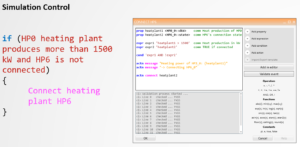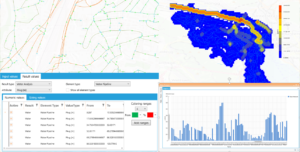This basic module enables the user to model, design and optimize his heating or cooling network using NEPLAN’s user friendly graphical interface and NEPLANs powerful, up-to-date calculation algorithms to address a wide range of applications.
General Characteristics
- Loads (consumers) can be changed through 3 different load factors (general, regional or simultaneity load factors).
- To each pipe any number of line loads can be connected (e.g. houses, heating …). Importing of consumers from existing databases (e.g. from an accounting database) is possible.
- All load and simultaneity factors of the line loads are considered during the calculation.
- The consumptions can be entered in different units (e.g. l/s m3/h, kW, t/h, etc).
- Simultaneous calculation of multiple partial networks (independent networks).
- Calculation of heat exchanger, heat plant, centrifugal and circulation pumps, reservoirs, valves, fittings, pressure regulators, etc.
- All elements have a temperature dependent thermo hydraulic model.
- It is possible to calculate only the forward flow. The return network must not be entered.
- It is possible to enter also the return network and calculate the forward and return network together.
- The calculation can be done without temperature losses. This can help to debug the network model.
- A powerful up-to-date calculation algorithm (Extended Newton Raphson) is implemented. This allows very easily inserting new element models. The complexity of the models is no longer restricted.
- The head loss characteristics of the pipes are calculated according to Prandtl-Colebrook and Hagen-Poiseuille.
- A load library (household, industrial loads …) with different simultaneity factors can be defined.
- Sophisticated pump and valve models, which allows regulating pressure, flow, pressure differences at any node or element.
Results
Upon calculations, results are automatically displayed on the single line diagram while their content and graphical information can be customized. Result evaluation and processing is easier due to visualization functions:
- Coloring according to variable ranges (e.g. velocity, flow, pressure-losses, pressure etc.)
- Highlighting of overloaded elements (e.g. velocity v > v max)
- Line width proportionally to many variables, including the flow and diameter
- Result output to an excel like table sheet, with copy/past possibilities to MS-Excel
- Result display in a charts (e.g. bar or line chart)
- Self-defined result output: the user can select units, variables, font, precision, placement
- Comparing results was never easier: Results from other variants can be displayed in the same result label and in the same chart
- Display the temperature, temperature losses and power losses in the diagram and in excel like table sheet
Contingency Analysis
Contingency analysis or N-1 analysis is used to determine the security of a network as well as the importance of the components. The outage list can include any element, and also common mode definitions are possible (simultaneous equipment failure). The basis of the Contingency Analysis is a fast heating/cooling network calculation. All defined outages are calculated and their impact is reported in terms of violations caused. The results can be viewed in tables and charts and the offered tools are aiding the engineers for the ranking of severity of each outage.
Remedial Actions (Event Definition)
The Remedial Action Schemes (RAS) is a separate module and could be licensed with the modules Heating Calculation and Contingency Analysis.
The user can define custom events for a series of heating or cooling network calculations. With the defined events, the status of the simulated network can be controlled, e.g. connect of a heating plant in case of limit violation so that the violation disappears. This module contains, beyond the standard control capability of the heating / cooling network calculation, powerful functions to observe and control the network.

